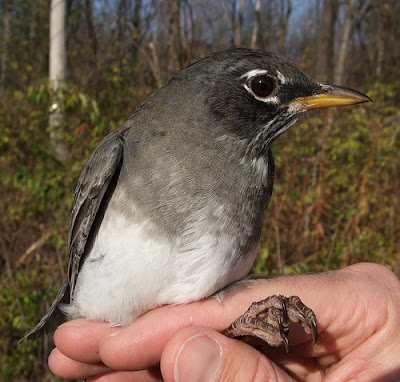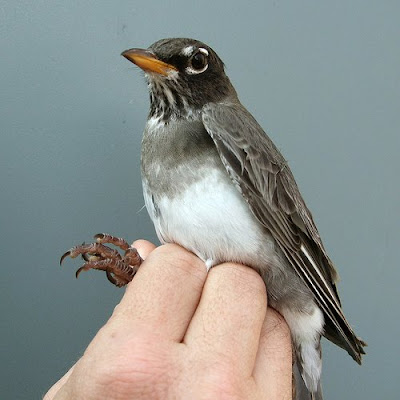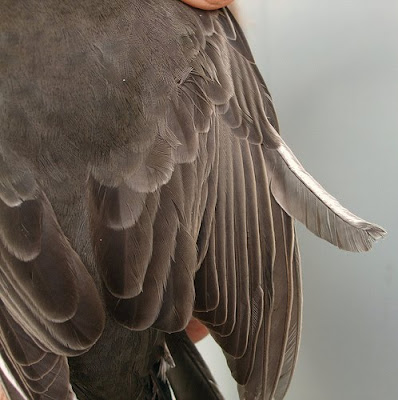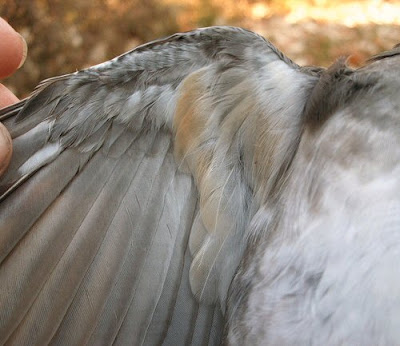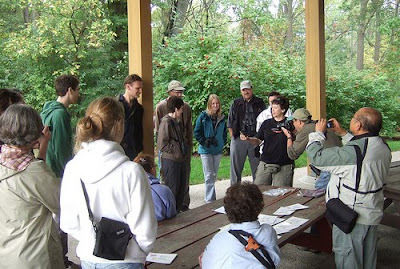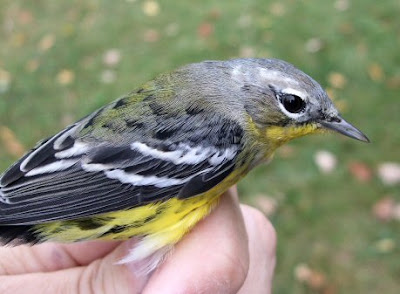RRBO's 19th fall banding season got underway this week. First, a big thanks to local birder and RRBO volunteer Jim Fowler, who decided his songbird banding days are behind him, for donating his net poles to us. And to Robert Schubert, EIC student staffer, for cutting a whole batch more. We have a full set of straight poles to work with this season. Robert and Dana Wloch, one of my undergraduate research assistants, also helped out with getting the net lanes ready for banding. Many thanks!
The first week of banding usually starts slowly, as I tend to be putzing around pruning net lanes and putting up the final nets. This week there were 78 new birds banded, 4 recaptures, and 18 birds released unbanded (14 Ruby-throated Hummingbirds, the rest House Sparrows). This represented 25 species. Most were local breeders, but migrants included Least and Yellow-bellied Flycatchers; and Black-and-White, Nashville, Magnolia, and Chestnut-sided Warblers.
Most of the locally nesting species have one thing in common this time of year: they are in the midst of their fall molt. Once finished with nesting, adult birds replace all of their feathers. It occurs systematically, so they can still fly, but not quite as well. Thus a lot of adults tend to be a bit secretive.
 Gray Catbirds are our #1 species. This adult female was originally banded in May 2008, and recaptured this week. What a mess.
Gray Catbirds are our #1 species. This adult female was originally banded in May 2008, and recaptured this week. What a mess. Young birds (born this year and called "hatching year", HY for short) are also beginning to molt heavily now, replacing their juvenal* plumage with their first set of adult feathers. This HY catbird is actually one of the better looking individuals.
Young birds (born this year and called "hatching year", HY for short) are also beginning to molt heavily now, replacing their juvenal* plumage with their first set of adult feathers. This HY catbird is actually one of the better looking individuals. Most HY songbirds only molt body feathers, but some species also replace some flight feathers (wing or tail). Upon examination, it looked like this disheveled HY Song Sparrow lost its tail and was replacing it, versus a normal molt. The rest of the messy look was typical, though.
Most HY songbirds only molt body feathers, but some species also replace some flight feathers (wing or tail). Upon examination, it looked like this disheveled HY Song Sparrow lost its tail and was replacing it, versus a normal molt. The rest of the messy look was typical, though. Indigo Buntings nest on campus, but I've never had a nest in the banding area until this season. This recently fledged bird was being tended by a male parent, or I might have had a hard time figuring out what species it was! When I catch a bird this young, I immediately run back to the banding lab, process the bird, and run back and return it where I found it. Once reunited with his offspring, the dad quit scolding me!
Indigo Buntings nest on campus, but I've never had a nest in the banding area until this season. This recently fledged bird was being tended by a male parent, or I might have had a hard time figuring out what species it was! When I catch a bird this young, I immediately run back to the banding lab, process the bird, and run back and return it where I found it. Once reunited with his offspring, the dad quit scolding me! Up to about 5 or 6 years ago, Blue-gray Gnatcatchers didn't nest on campus. In fact, 20 years ago, I don't remember them nesting very frequently in the county. During the first Michigan Breeding Bird Atlas (1983-1988), breeding evidence was noted in only four quarter-townships in Wayne Co. Things have changed rather dramatically. During Michigan Breeding Bird Atlas II (2001-2007), 39 quarter-townships had breeding evidence, and for the last few years, three to five pairs have nested on campus. This HY bird, likely from a family that has been present this summer near the banding area, is only the 12th RRBO has banded since 1992, and only the second in fall.
Up to about 5 or 6 years ago, Blue-gray Gnatcatchers didn't nest on campus. In fact, 20 years ago, I don't remember them nesting very frequently in the county. During the first Michigan Breeding Bird Atlas (1983-1988), breeding evidence was noted in only four quarter-townships in Wayne Co. Things have changed rather dramatically. During Michigan Breeding Bird Atlas II (2001-2007), 39 quarter-townships had breeding evidence, and for the last few years, three to five pairs have nested on campus. This HY bird, likely from a family that has been present this summer near the banding area, is only the 12th RRBO has banded since 1992, and only the second in fall.Two interesting "abnormal" birds were banded this week.
 This HY Eastern Kingbird, probably from a nest on campus, had fleshy tumors on the "shoulders" of both wings. The tumor on the left wing was small, but this one on the right wing was 14.2 mm. I see tumors of this sort from time to time. I suspect this was a feather cyst; a contributing factor for this condition may be malnutrition. This bird also had a prominent "fault bar" on the tail. This occurs when actively growing feathers stop growing for a period of time due to nutritional stress (lengthy discussion here). The bird flew well, but it's hard to say how much this will hamper it on its long fall migration.
This HY Eastern Kingbird, probably from a nest on campus, had fleshy tumors on the "shoulders" of both wings. The tumor on the left wing was small, but this one on the right wing was 14.2 mm. I see tumors of this sort from time to time. I suspect this was a feather cyst; a contributing factor for this condition may be malnutrition. This bird also had a prominent "fault bar" on the tail. This occurs when actively growing feathers stop growing for a period of time due to nutritional stress (lengthy discussion here). The bird flew well, but it's hard to say how much this will hamper it on its long fall migration. American Goldfinches are abundant in one section of the banding area. They are just starting to fledge their young. This bird, however, was an adult male. Note that the first secondary feather on one wing was completely black on the underside, rather than having a white base. Usually when one sees birds with odd-colored feathers, the aberrant feather is white. Excessive dark plumage, or melanism, is less common, and I don't recall ever seeing single melanistic feathers or patches of melanistic feathers any birds, much less the many thousands of goldfinches I've handled.
American Goldfinches are abundant in one section of the banding area. They are just starting to fledge their young. This bird, however, was an adult male. Note that the first secondary feather on one wing was completely black on the underside, rather than having a white base. Usually when one sees birds with odd-colored feathers, the aberrant feather is white. Excessive dark plumage, or melanism, is less common, and I don't recall ever seeing single melanistic feathers or patches of melanistic feathers any birds, much less the many thousands of goldfinches I've handled.This will be the fourth year of collecting fecal samples from Catharus thrushes to examine what kinds of fruit they are eating. It's the second year that Dana Wloch will be assisting by collecting and compiling samples from other bird species. This week resulted in 19 samples being "donated" by catbirds, American Robins, and a couple of Cedar Waxwings.
Welcome rain and the passage of a front this weekend should perk things up next week.
***
*"Juvenal" is the term for a bird's first plumage; "juvenile" is a generic term for a youngster. For more on plumages and molts, extremely useful in aiding in ageing and identification of birds, Plumage and Molt at Audubon Guides, and Molt and Plumage Lab at Biological Ramblings. An excellent new book on the topic for birders, Peterson Reference Guide to Molt in North American Birds










